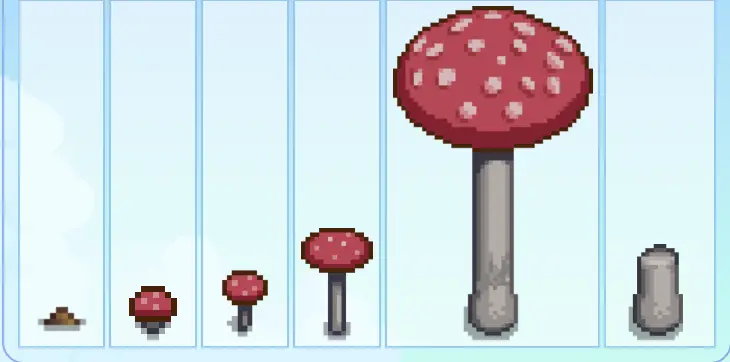Giant Mushroom Stardew: How to Grow, Harvest, and Profit

In the cozy and captivating world of Stardew Valley, one arboreal oddity has been perplexing farmers for years—the Mushroom Tree. If you’ve ever wondered, “How did I end up with a Mushroom Tree on my farm?” or “What are its uses?”, we’re here to illuminate those shadowy corners of knowledge for you.
How to Get a Mushroom Tree
Wild Transformation
Would you believe that any regular tree—pine, oak, maple, and mahogany—can magically transform into a Mushroom Tree? During the autumn season, wild trees have a 5% chance of turning into Mushroom Trees, adding another layer of excitement. The more trees you have, the better the odds. If you have tree stumps, they too can turn into Mushroom Tree stumps.
From Seed to Tree
For those with a less patient disposition, head over to Mr. Qi’s Walnut Room and spend 5 Qi gems on a Mushroom Tree seed. With a 20% chance of growing to the next stage each day, you can get a full-grown tree in about 24 days. If you’re in a rush, using tree fertilizer will cut this time to 5 days.

Growing and Spreading
If you’re interested in a full-fledged mushroom forest, ensure you clear the grass and other obstructions around your existing Mushroom Trees. These conditions encourage seed dispersal and mushroom sprouting.
Mushroom Trees won’t grow to maturity if another fully-grown tree is beside them, so give them room to breathe.

Chopping and Drops
Cutting down a Mushroom Tree gives you 5–6 Red Mushrooms, with a minuscule chance of getting a Purple Mushroom. There’s a 1% chance of getting a coveted Mushroom Cap as well. Lumberjacks, beware! Your Forester skill won’t help you get more mushrooms.
Seasonal Behavior and Harvesting
Winter and Rebirth
Come winter, your Mushroom Trees outdoors turn into stumps, but those in the Greenhouse or on Ginger Island remain untouched. These stumps regenerate in spring. For strategic gameplay, cut your outdoor Mushroom Trees just before winter and Greenhouse/Ginger Island trees before spring to harvest Mushroom Caps.
Tapping for Sap
Install a tapper on your Mushroom Tree and harvest every two days. The tapper continues working through winter but will not produce anything. Heavier tappers have no effect; you still collect sap every two days.
Mushroom Cycles
Now, here’s a puzzling part. Except for autumn, if you collect sap every two days, you can expect a cycle of Common Mushrooms, followed by a Purple Mushroom on either the 10th or the 20th day of the month, then a Red Mushroom, and the cycle repeats.
Special Features
Interestingly, if a Mushroom Tree is struck by lightning, it is reduced to a stump but leaves behind mushrooms. While they might seem dead during winter, they are far from it. They will regrow into full trees in the spring, as long as they aren’t chopped down.
Mushroom Recipes and Cooking
Common mushrooms aren’t just for selling; they can be incorporated into a variety of recipes for energy boosts. Whether it’s to gift villagers or for personal consumption, the culinary applications are endless.

Advanced Tips: The Aesthetics and the Alchemy

For players like you who have mushroom caves and seek Mushroom Trees for aesthetic pleasure, imagine if the game introduced special mushrooms with unique abilities? A beautiful mushroom forest could not only be a visual spectacle but a cauldron of magical possibilities.
Community Perspectives
The Stardew Valley community has mixed feelings about Mushroom Trees. Some players love them for their culinary applications and unique aesthetics. Others consider them an unnecessary addition, mainly due to their seemingly random placement and tendency to produce common mushrooms. Regardless, many are excited or disappointed to see them on their farm, showing the wide range of sentiments surrounding these special trees.
To Wrap Up
Stardew Valley’s Mushroom Trees are more than just strange flora; they are a source of intrigue and strategy. Whether you let nature take its course or manipulate it to your advantage, these enigmatic trees make your farming life a little more magical.
Feel free to let us know how your adventures with Mushroom Trees go. Maybe next season, you could be walking through your very own enchanted mushroom forest!